London Fashions May 1888
"Ne'er cast a clout till May be out" is an old saying which has a good deal of truth in it; but when May comes, our minds want to be much occupied with "changing of clouts," though we may not be able to carry our plans into action till June roses blossom.
Some few years ago fashionable women appeared outdoor, as soon as summer came, "in their figure," as the French say—such as, without any unique mantle or outdoor garment. Whether old or young, fat or thin, all women seemed to follow the same idea.
To a certain extent also the bodices were all cut on one pattern, with coat sleeves and basques varied only by more or less trimming. It required a courageous woman, if she were still young, and yet chilly by nature, perhaps not over robust in health, to muffle herself up in a mantle.
Now we are going into the contrary extreme; and however hot the weather, however youthful the wearer, a mantle, jacket, or cape of some kind would seem to be a necessity.
The only exception this year is likely to be when an Incroyable coat is worn, for then any extraneous covering would be very like what in homely parlance is known as "putting butter on bacon."
To have appeared at a smart fete in a mantle some years ago would have been looked upon as the essence of dowdiness. Now the new models are so becoming to a good figure that few well-dressed women would care to be seen without one; especially strengthened by the all-important knowledge to the average female mind that they are correct and orthodox.
Thin arms can hide beneath cape-like sleeves, or sacques of lace, or rows of fringe; and those who suffer from embonpoint may disguise it by trimmings of falling pendent drops, which serve in such marvelous fashion to diminish apparent bulk.
Indeed, there is nothing to complain of in the fact that Fashion has declared herself in favor of outdoor coverings, for the new mantles of the season are singularly elegant; and it would not be a satisfactory calculation to reckon how many lives have been sacrificed to inadequate clothing.
Bonnets that do not cover the head, tender throats left unduly exposed, and colds caught by insufficient coverings—to say nothing of the loss of energy and vitality due to bad health.
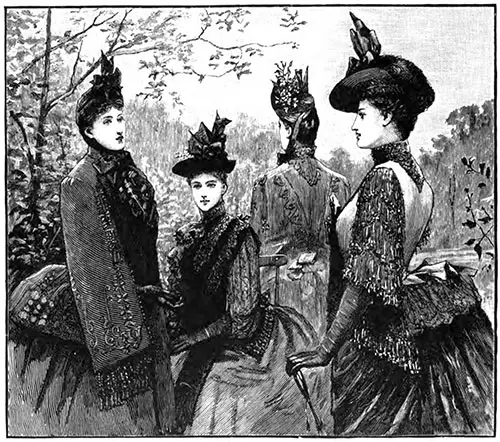
New Spring Mantles
The first figure in the illustration of Messrs. Lewis and Allenby's new mantles wears what is most difficult to obtain —a becoming mantle for a woman who is no longer young. It is made in black corded silk, rich of texture is well, soft and supple, yielding to every line of the figure.
The long pendant sleeve-piece, distinct from the shoulder, entirely covers the arm. It is trimmed with silk passementerie, in which there is no admixture of beads; the sides are edged with close-set gimp, and fringe borders the lower edge.
From the throat, the front is almost hidden by black lace with a design of boules or balls as large as marbles. This falls below the mantle in two long ends and mingles with the skirt draperies.
The basque at the back is somewhat longer than in those cloaks intended for younger women, and it is trimmed to match the sleeves.
The next figure (seated) wears a velvet mantle, a material which is likely to find as much favor in June as in March. Note how becomingly the high lace-trimmed collar encircles the slender throat, and from it starts a lace jabot, falling to the waist.
The trimming, carried diagonally from the shoulder to the bust, is a brown and gold galon made of open cord-work, and appears again on the basque, which is drawn up extremely short in the center of the waist at the back, beneath a bow which is duplicated on the shoulders.
This basque ends beneath the arms, meeting the long narrow fronts, into which are inserted puffings of lace, slashed like a Tudor sleeve.
The sleeve, in this instance, is all lace and illustrates one of the newest features in present fashions—the sack-sleeve—which supports the elbow and allows the arm to pass through it below the forearm.
The third figure in the foreground wears a light-colored mantle trimmed with the finest jet. The color may be wild-thyme-green, beige-red, or some of the golden-brown, as well as black; or it can be made in one of the transparent brocaded gauzes, with colored linings.
The jet-work, entirely composed of fine cut beads (which glisten like so many diamonds), ends in the front in a large bow on the bust. Here the shape indicates the figure but does not define it, as it does most faithfully at the back.
Like all the new shapes, this mantle needs a well-draped skirt beneath it, well - petticoated, throwing it out sufficiently and not too much. The importance of this can hardly be too strongly impressed on those who desire to dress well.
It is on this account that models are apt to look so much better in the showrooms than when they reach home, for those who are engaged to display them are most careful of all these details.
It is the minute personal study which a Frenchwoman devotes to every item of the costume, however insignificant, which makes her so often excel our countrywomen in the result.
Smart little cloth jackets—in beige color, dark blue, dark brown, grey, and black—for young girls are made with much variety as to the cut in front; at the back, they are very short and fit closely.
Sometimes they fasten diagonally; in other examples, they have one revers; and in the variety and daintiness of the waistcoats, there is no end.
The cream-faced cloth jacket, with flat gilt coin buttons, still carries off the palm. Its trimness is suggestive of a vivandière, though it does not lose one whit of its lady-like style thereby.
"Let your face be younger than your Costume" is sound advice, given by one who knew; and it especially applies to that part of the dress which comes under the head of a millinery.
The choice of a bonnet is, perhaps, the most important of the decisions which have to be made so continually with regard to dress.
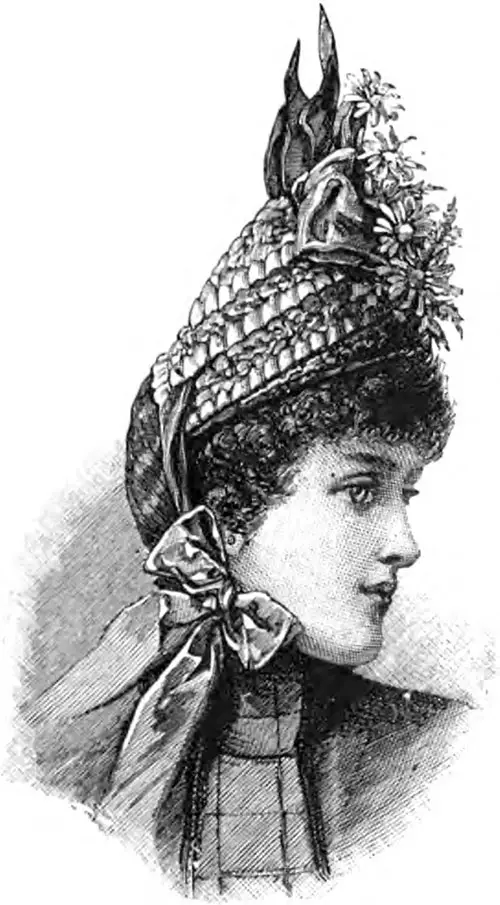
Pith Bonnet
Natural materials are playing an all-important part in bonnets. The bright young face on this page is framed in one composed entirely of a plaited pith fabric hitherto used for trimming but introduced by Mme. Valerie, of New Burlington Street, as a fabric useful for the entire bonnet.
It is of a pinky string tinge; the insertions are sewn closely together; the crown is of the horseshoe form, slightly indented; the brim turns backward; and above, the beige-toned ribbons and the white marguerites stand up boldly.
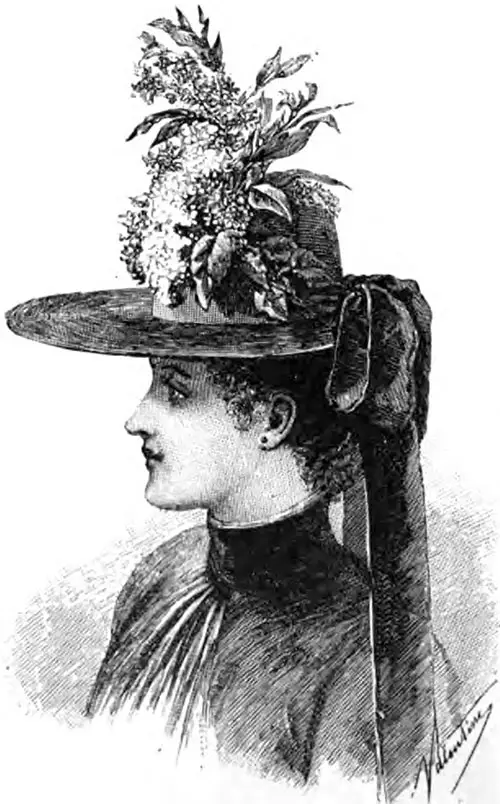
Hat Trimmed with Lilac
The hat on this same page has a broad brim in front, which becomes considerably shallower at the back, where it is hidden by a bow of mousse velvet. Above the crown is a gigantic loose bouquet of lilac.
Fashionable hats all resemble walking gardens, and the crowns are so hidden under flowers that it is difficult to tell of what they are composed. Perhaps it is on that account they are often quite different from the rest of the hat; sometimes, with firm, sturdy straw brims, crepe and tulle drawn crowns serve for the foundations on which the flowers rest.
So decidedly has Lady Fashion gone hand-in-hand with Dame Nature this year, that nothing in flowers is à la mode unless it looks as if it had just been gathered in the garden and tied up loosely, and there and then set in its place to stand erect, according to its own sweet will.
Rushes from sedgy banks have been chemically treated and transferred to bonnets, with real grasses, real lavender, and real rose-twigs—all submitted to a treatment which renders them hard and durable.
A shaded ribbon may be substituted for ribbon velvet on this hat, and the side can be turned up to suit the wearer. The brim is lined, but not bound, with velvet.
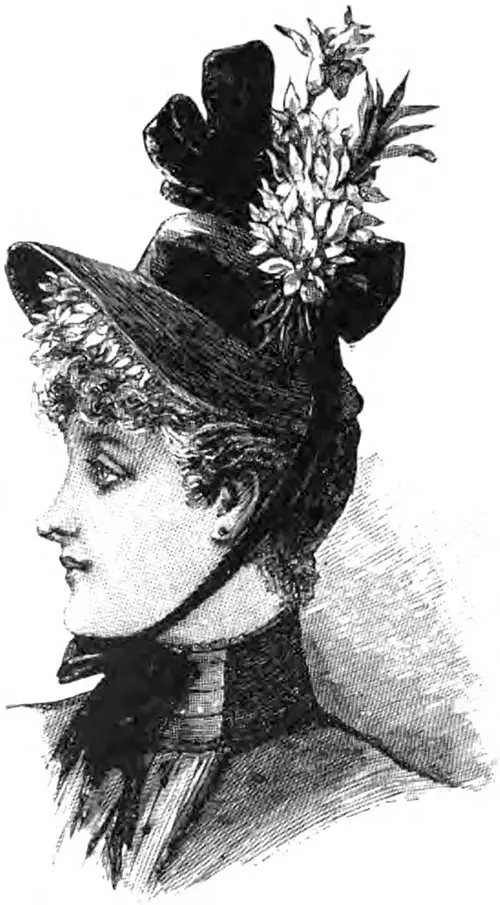
The Empire Bonnet
The bonnet in the right corner of this page recalls the Empire period, and Mrs. Jordan in her youth when she played the Country Girl with such roistering vitality that she won all hearts. It has the flaring brim which proved so becoming in the Country Girl, and which requires a fringe of hair.
In later days we named a similar shape the "Langtry," but this present revival is slightly different. The black straw is elegant and supple, contrasting well with the daffodils beneath the brim, and the bunch which towers above the crown, intermixed with black velvet; the strings are also of black velvet, and quite narrow. This is essentially a young woman's bonnet.
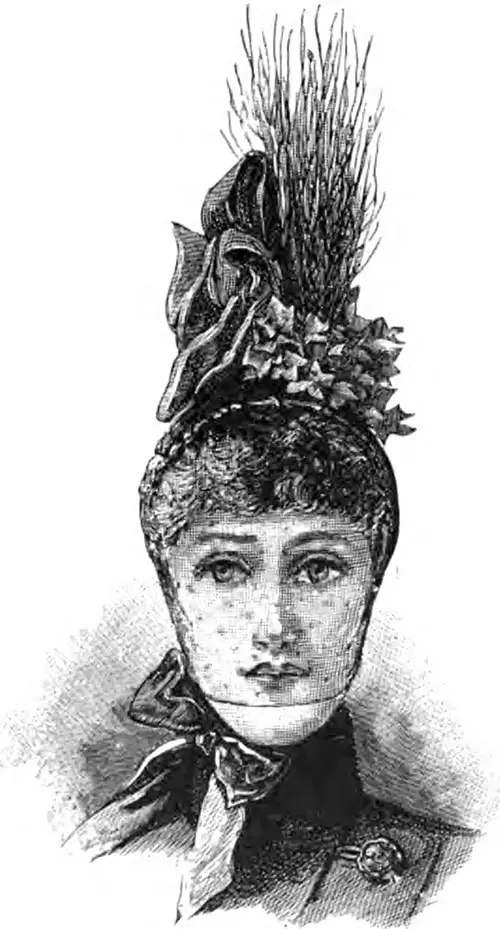
Black Horsehair Bonnet
Our next is an illustration of one of Mme. Valerie's black horsehair bonnets, embroidered in gold; for there is almost as much of a gold-fever in the dress now as there was in Australia in mines some years ago.
Our model is trimmed with gold wheat-ears, and ivy-leaves were matching in tone the large green ribbon bow at the side. There is a bow under the brim of this bonnet, and the strings are of black velvet.
Among costume novelties, a preparation called Pasta Mack has been introduced. It is a white powder made up into tablets, and when mixed with warm water, either in bath or hand-basin, it imparts to the water a most delightful perfume.
Veils are still worn across the face, made of spotted tulle. The spider-web net is so becoming that many prefer it to the spots. Tulle Ecossais, with tiny floral patterns, is also new. Its merit is the fineness of the groundwork on which these infinitesimal flowers are worked.
By the way, now that summer is approaching and presumably, warm weather, we would recommend to women and growing girls who affect soft, flexible stays, to try Dr. Brooks' Patent Knitted Corsets. For young girls' wear especially, they are admirable, also for wearing when boating and playing tennis, cricket, etc.
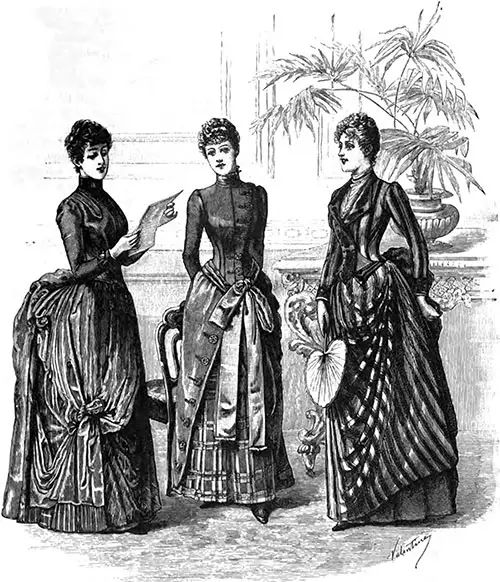
Indoor Costumes
The group of three dresses made by Messrs. Redmayne, of New Bond Street, indicates the prevailing styles in spring dress-making. The first damsel wears a soft silk gown shot in red and blue, for it would seem to be quite impossible now to ignore shot effects.
If they are not apparent in the bonnet, they must be in the dress, or even in the stockings. In woven materials, this shot effect is produced chiefly by the warp and the woof being of two colors.
However, in ribbons this is not always so; the changeant or chameleon effect is brought about by dyeing one color upon another so that the first tone is seen through the other in certain lights.
In our model, however, the plain interweaved shot is mixed with a stripe thrown on a shot ground; for it must be borne in mind, in choosing new gowns, that stripes are the leading characteristics of les modes as they are.
The ends of the scarf draperies are edged with crystal beads, also introduced around the front of the bodice at the waist, which ends there abruptly, like some of the Directoire coats.
Cross-cut pleats come from the shoulder of this same bodice, and there is a pointed strap carried over the shoulder on to the front. On the opposite side, the drapery is arranged without the ends and is continued to the back.
In the middle figure, we have an example of one of the many coat draperies which are to be worn as the summer ripens and have been growing steadily in favor during the springtide.
The petticoat is composed of a check material of unique coloring — salmon, butter color, brown, electric blue, all interblended, but with the subtle art which characterizes the prevailing color amalgamations, no one tone being permitted to clash with the other.
Electric blue is, however, the dominant lint here, and it is in this that the bodice and sides of the skirt are made, soft Veloutine being the material employed. The bodice fastens diagonally, and the waist is outlined by a ribbon which is tied loosely in the immediate front.
Very large buttons are used, and also on the side of the skirt. This appears to be entirely gathered to the bodice and is full at the back. The opposite side to that principally displayed in the picture is caught up in easy folds to the waist so that it forms a curtain like drapery at the side.
In the cuffs, which are hidden in the sketch, a little of the checked material is introduced. A blue of a different tone is employed for the groundwork of the third illustration— woolen stuff, which is mixed with white in the stripe.
On the right side, there is a dark blue panel of silk, while on the other the striped upper skirt is simply caught up carelessly at the waist. The bodice is double-breasted and has silk revers. Beneath these revers is a ruffled vest of soft silk of a cream tone.
Johnstone, Violette, “May Fashions,” in The Woman’s World, Cassell & Company, Limited, London, Paris, New York & Melbourne, Volume I, No. 7, May 1888, p. 329-332.
Note: We have edited this text to correct grammatical errors and improve word choice to clarify the article for today’s readers. Changes made are typically minor, and we often left passive text “as is.” Those who need to quote the article directly should verify any changes by reviewing the original material.

